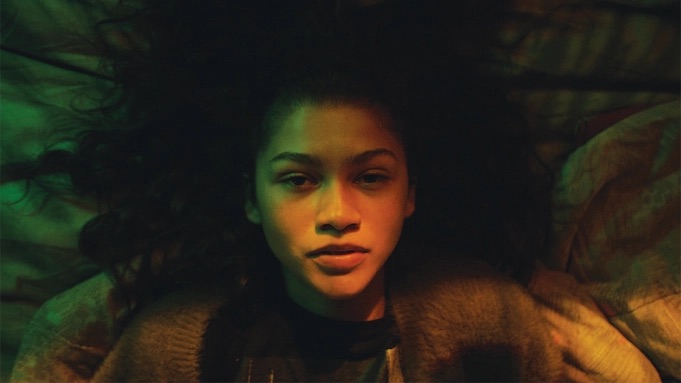Is “Euphoria” Toxic?
Looking back on the second season, the HBO show realistically depicted the tragic consequences of addiction and abuse, despite claims of glamorizing trauma and drug use
As “Euphoria” has come to a close, I look back with nostalgia at my weekly ritual, watching the show each Sunday at 6 p.m. for eight weeks. What attracted me at first was the extravagant and thoughtful makeup and wardrobe. Maddie’s wardrobe alone looks like she crawled out of a crowded, A-list club where she snuck in solely based on confidence. The character, played by Alexa Demie, is known simply for the drama that consumes her entire look. She wears rhinestone eyeliner and 6-inch platforms on a Tuesday morning which perfectly sums up her personality. But as I kept watching I got hooked on the dramatic plot. I’ve seen many comments and opinions on the show but the most popular one is that the show’s mature themes are too dark and they romanticize drugs too much. This effect has been accused of being dangerous because the show’s target audience is teenagers and people are concerned that the show will influence them too much. I partially agree with this statement, but I think this new generation of teenagers is already more mature.
The HBO show follows Rue, played by Zendaya, a teen who portrays the effects of drug addiction on teen development, mental health and love, as she teeters on the edge of sobriety. At first viewers are shown this euphoric, aesthetically pleasing cinematography that keeps their eyes glued to the screen. The camera movements force the viewer to experience the situation with the same feelings as the characters, like when Rue is high and starts walking on walls and the camera stumbles with her. The lighting perfectly sets the mood and almost foreshadows what is about to happen next. The editing and sharp cuts really dictate the rhythm and pacing of the show to make the watching process feel almost like a theme park ride.
As the series progresses however, we see each character spiral into some kind of traumatic situation. I understand the concern of having the glamorized parts act as a first impression and that it might be the only thing teens focus on, but our new generation is a lot smarter with the way we perceive media. A lot of times that’s beyond our control but with TV shows there’s still a lot of room to separate a plot from reality.
Although they show teens dabbling in molly and cocaine at the occasional party and display their highs as almost an aesthetic, colorful performing art piece, they also show the harmful effects of drug dependency. Rue destroys most of her relationships because she has to hide her addictions and lashes out while under the influence. By adding these details, the writers really convey the feeling of addiction completely tearing the veil that a euphoric high creates to reveal a much more destructive and traumatic underside to drugs.
I will admit, depicting the character’s highs as a somewhat spiritual experience can create a romanticized image of drugs. The director takes each scene as an opportunity to create visual artwork, and it stands out for how explosive it is. The episodes are packed with some pop-culture or art references, which makes it feel more like an indie movie.This makes sense because the show is produced by A24 which is known for making a large production with big names while still maintaining the feel of an intimate, independent film. But those scenes of Rue completely breaking down are the ones that really stick. The scenes that don’t have any imagery or reference or any snuff detailing. It’s just a camera and a person. Those intimate, heartbreaking moments are what make the show notable for me.
There are certain instances where they don’t show immediate consequences for drinking or doing drugs irresponsibly but they always have some major effect developed later on. For example [possible spoiler alert] that whole storyline with Rue trying to finds a way to get free drugs and makes a fake business deal with a drug dealer. Her mom ends up finding the drug-filled case and flushes them all down the toilet leaving Rue to have to go through deperate measures to get the $10,000 the drugs were worth. The drug dealer had threatened her beforehand that if she were unable to come up with the money she could sell her or do something equally as horrifying [spoiler alert over].This adds to the suspense that the writers are trying to build throughout each episode. If every little detail was completely accurate then it would be a documentary. “Euphoria” is created for entertainment, so while the events are based on real life, everything is dramaticized so that the viewer will want to watch the next episode. The purpose for glamorizing drugs then slowly showing the harmful outcomes is to do just that: get you hooked to the story.
In my case, it’s working.
I will say that a lot of the time the director Sam Levinson tries to appeal to shock factor through violence or nudity, and it feels unnecessary sometimes. Multiple “Euphoria” actresses have expressed to Levinson that certain scenes he intended to be nude didn’t need to be. For instance Sydney Sweeney, the actress who plays Cassie, is wearing some type of revealing clothing all the time that draws attention only to her chest when it adds nothing to the story at all. In another scene featuring new character Faye, the actress Chloe Cherry had to fight with Levinson on whether she should take off her pants when a drug dealer strips her for wires. However, this is HBO and they are notorious for filming lots of nudity as a way to ‘push the envelope’. Still, a majority of the scenes involving Rue and her drug use can get pretty graphic, so I advise some caution if you are easily triggered. There are some scenes where she’s about to overdose and looks like she’s almost dying but still crushes and snorts some unknown substance to fight it off and Zendaya’s portrayal makes it look a little too realistic. Despite the depressing tone this show may come off as, there are also some good messages that can help uplift teens who are going through a similar situation.
Similarly, Jules is a transgender character who had more of a developed storyline in season one as she was trying to find her own femininity. She struggled with appealing to the male gaze for validation and wearing hyper-feminine outfits and makeup to feel pretty. But in season two, she’s finally broken her unhealthy habits surrounding men and wears whatever she wants whether it’s traditionally feminine or not. Her growth as a character could offer comfort to someone going through their own journey and assure them that they are the only ones who can define their gender expression. They don’t need to fit in a box, they just need to be themselves.
Overall I think “Euphoria” is definitely worth the rave and the show does a pretty good job of showing the effects of substance abuse. While the themes are intense, they are also pretty general themes when it comes to drama shows. If you think about “Shameless” and “Breaking Bad”, these shows were talking about the same issues 10 years ago. It just wasn’t as pretty as “Euphoria.” Even though those shows weren’t exactly aimed towards teenagers, younger audiences still watched them because of how entertaining they were. Additionally, each generation continues to grow up more mature than the last because of our fast-paced world so, by that logic, “Euphoria” is just following the wave and I’m another teen hooked on a dramatic and mature show.

My name is Izzie and I'm a senior staff writer. I've been on staff for 2 years and it's been a lot of fun. I originally joined because of my obsession with Gilmore Girls and Sex and the City and wanting...



